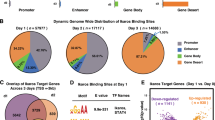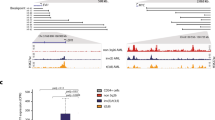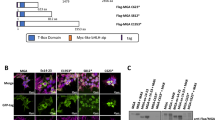Abstract
The HOX11 proto-oncogene is normally expressed in embryogenesis where it directs the synthesis of the spleen. In adult tissues, HOX11 expression is silenced by an unknown mechanism. Aberrant expression of HOX11 occurs in T-cell acute lymphoblastic leukaemia (T-ALL), where it is thought to be involved in T-cell immortalization. The deregulated expression of HOX11 is frequently associated with chromosomal translocations which juxtapose a T-cell receptor (TCR) gene upstream of the HOX11 gene. In these cases, it is presumed that the activation of HOX11 expression results from bringing the gene under the control of TCR enhancer elements. However, activation of HOX11 also occurs in the absence of an associated translocation in both T-ALL and erythroleukaemia cells, implying that an alternative activation mechanism may exist. We hypothesized that HOX11 may be repressed in normal T-cells and erythroid cells by the action of negative elements which may be deleted or mutated in leukaemia. We therefore conducted a search for negative elements in the human HOX11 promoter which may function to silence its expression in normal cells of the haematopoietic lineages. Since little sequence of the HOX11 promoter was available, we began our investigation by sequencing over 4.5 kilobases of untranslated DNA from upstream of HOX11. The human sequence that overlaps with the 2.1 kb of murine Hox11 is highly conserved, suggesting that a large region of DNA upstream of HOX11 may have a regulatory function. We then used transfection assays to test the ability of portions of the promoter to drive transcription of a reporter gene. These studies identified four negative elements. Two of them (NRE2 and NRE4) function in all cell lines tested, while the remaining two (NRE1 and NRE3) appear to be cell-type specific. The DNA sequences of three elements are conserved between the human and mouse HOX11/Hox11 promoters. We propose a model in which the combined action of these negative elements contributes to the overall repression of HOX11 expression in normal blood cells.
This is a preview of subscription content, access via your institution
Access options
Subscribe to this journal
Receive 50 print issues and online access
$259.00 per year
only $5.18 per issue
Buy this article
- Purchase on Springer Link
- Instant access to full article PDF
Prices may be subject to local taxes which are calculated during checkout
Similar content being viewed by others
Author information
Authors and Affiliations
Rights and permissions
About this article
Cite this article
Brake, R., Kees, U. & Watt, P. Multiple negative elements contribute to repression of the HOX11 proto-oncogene. Oncogene 17, 1787–1795 (1998). https://doi.org/10.1038/sj.onc.1202078
Received:
Revised:
Accepted:
Published:
Issue Date:
DOI: https://doi.org/10.1038/sj.onc.1202078
Keywords
This article is cited by
-
Cytogenetics and molecular genetics of T-cell acute lymphoblastic leukemia: from thymocyte to lymphoblast
Leukemia (2006)
-
Expression of HOX11 in childhood T-lineage acute lymphoblastic leukaemia can occur in the absence of cytogenetic aberration at 10q24: a study from the Children's Cancer Group (CCG)
Leukemia (2003)



